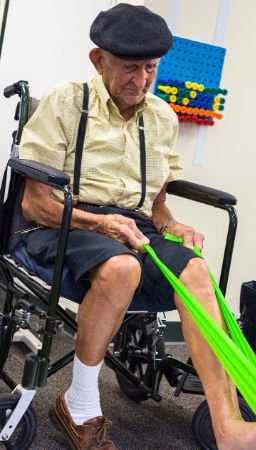
Source: The Michael J Fox Foundation
Michael J. Fox, Family Ties and film star, put a name and a face on Parkinson’s disease. Parkinson’s Disease is a progressive illness of the nervous system and the symptoms include muscular rigidity, tremors, and imprecise movement. Michael J. Fox was diagnosed with Parkinson’s at the young age of thirty. This is unusual because Parkinson’s typically affects the middle-aged and elderly.
According to the Parkinson’s Foundation, the symptoms of Parkinson’s occurs because of insufficient levels of the chemical dopamine, which sends messages to the part of the brain that controls movement and coordination. The brain produces less and less dopamine as Parkinson’s progresses, depriving the person of the ability to control movement.
Although Parkinson’s can seem daunting, doctors, educators and even clients who have PD are continually making advances in research and studies concerning it. Some of these results have shown that exercise and body movement can help people with PD lead productive lives. There are two organizations that are specifically focused on these studies of movement in relation to PD: the Michael J. Fox Foundation and The Davis Phinney Foundation.
Who is Davis Phinney?
The Davis Phinney Foundation was founded in 2004 by the Olympic medalist for cycling, Davis Phinney. Phinney was diagnosed with PD in 2000 at the age of 40. About 1.5 million Americans live with Parkinson’s Disease. Davis works with his foundation tirelessly to help inform and inspire people to continue fighting for their ease of life. After his initial diagnosis, Phinney sought to find a way to live his best life and to aid others in taking back their quality of life. The Davis Phinney Foundation encourages people with PD to reject passivity and to throw themselves back into the movement of life.

Source: The Denver Post
On his website, Phinney talks about not allowing tremors and dyskinesias (difficulty performing voluntary movements, such as lifting items) to control his life. Dyskinesias often occurs as a side effect of long-term therapy using levodopa, which is a medication given to PD clients to help boost declining levels of dopamine production in the brain.
Phinney was understandably frustrated with his bodily control when he began training again, but he worked to overcome this with exercises that increased both his overall well-being and his muscular control. He is a great example of perseverance and determination in the face of PD can look like.
How exercise has changed Phinney’s life
Phinney has taken up cycling again. He attributes his success to training his brain with reminders to hold his arms straight, keep his feet from dropping etc. It was tedious work, but the more he did this, the more he was able to overcome his PD. Phinney’s body acclimated to riding again. He now he cycles for 20-30 minute periods. He sweats, moves, and feels great, and notes that the untrained eye seeing him on the bike wouldn’t notice any difference in his skills. Phinney concludes that: “it is only noticeable when I don’t keep at this. Then I don’t function well.”
Phinney’s experience and findings supports what medical research is now saying. People with PD often face a deterioration in mobility and activities of daily living (ADL’s). Exercise often stops the decline and symptoms of the disease. Continued exercise improves a person with Parkinson’s quality of life and allows them to have independence. No one wants to lose movement and coordination abilities, or deal with vocal problems—all of which cannot be readily helped by medication or surgery. Instead, the last decade has shown the significant and clinically meaningful benefits of exercise for persons with PD.
Here are the conclusions from three lines of research:
- Exercise studies of animal models with PD demonstrate improvements in function of nerve cells and the potential of increased survival of nerve cells within the affected area of the brain. Therefore, these findings suggest that exercise exerts its effects on the brain as well as the rest of the body.
- Exercise intervention studies with human participants identifies 20 or more high quality studies demonstrating that persons with PD who participated in exercise programs had better quality of life. Walking ability, flexibility, balance, strength, and cardiovascular fitness was markedly better when compared to those who did not exercise.
- Long term follow-up of persons as they age suggests that those who engage in moderate to vigorous exercise appear to have a significant decreased risk of developing Parkinson’s disease.
Utilizing physical activity properly
Doctors recommend that clients diagnosed with PD immediately see a physical therapist for an evaluation and a clearly defined exercise program. One trainer spoke countered the common phrase that any person should get permission from a doctor before starting exercise or physical activity. He pointed out that inactivity for any human is a greater threat to health than activity. Because problems associated with PD vary, each person should have a program tailor-made and approved by a neurologist or internist. The bottom line is that exercise – in small or large doses – should always be part of the standard of care. If a person stops his or her training, there will be progressive decline.

Aerobic activities, such as using a treadmill or bike, as well as a routine of lifting weights or using machines has many long-term health benefits. Having an exercise routine increases heart rate, helps lung function, builds stronger muscles, improves metabolism to fight weight gain and thus Type 2 Diabetes, and slows the course of PD. The brain benefits from blood flow which increases clarity of thought, improves mood, and excites neurons so that the person is more likely to feel in control of their life and body. Doing something is always better than doing nothing, especially when it comes to exercise.
Examples of a program designed for an individual client might include:
- stretching, extremely important and scheduled every day with concentration on the trunk to keep it flexible.
- resistance training with dumb bells, resistance bands, or machines 3 days a week for 30 minutes. Trainers will often emphasize a concentration on extensors, those muscles in the front of the thigh, the gluteus muscles and the extensor muscles that work the trunk and the back.
- walking is certainly exercise if it includes intensity, speed, inclines, etc. A walking program should produce sweating that indicates cardio-vascular involvement. If possible, PD clients should talk while exercising. Talking while exercising challenges the brain.
- spinning classes, which help provide resistance for upper and lower body; or stair machines that can help with balance training.
David Levanthal is an inspiring advocate for persons with PD is and is one of the founding teachers of a program entitled “Dance for PD”. Levanthal offers weekly classes at the Mark Morris Dance Center with the Brooklyn Parkinson Group. His Dance for PD has spread throughout America and to nine other countries worldwide. The purpose of the program is to have people with PD approach their condition with the mind of a dancer. Why? Because there is no wrong way to dance. Everything that dancers do to train their bodies can be useful in helping people with PD.
How these classes work:
These classes are always held in dance studios to highlight that a PD client is a dancer, not a patient. This viewpoint de-medicalizes the entire experience and changes the mental approach to the activity. The focus is on doing something completely removed from their condition. People in the class are not trying to solve a problem, they are there for mindset changes and life-long learning. Leventhal relates that the classes are inclusive and are never about what you can’t do. Everyone in the room participates, including doctors and caregivers.
These classes provide a different way for patients to take care of themselves. As Leventhal points out, dancers think about movement as training toward a goal. Leventhal trains every day and has danced for years. Music can guide and speak to the dancer with its rhythm and a patient with PD can use this to get out of a frozen state. Breaking out of a frozen state can be accomplished by always carrying a device with recorded music. If they feel a frozen state coming on, listening to the music and following it with movements can release them. Leventhal has also suggested harnessing the power of imagery. If a client with PD has to lift an arm, picture an apple on a tree and reach for it. Move with intent! It’s part of the dance and anyone and everyone is welcome to join in.

In conclusion: exercise in any form is more helpful than none, especially for a person dealing with Parkinson’s Disease. The connection between mind and body that exercise provides can help patients manage the symptoms of PD. Exercise can help recapture their autonomy and quality of life.


